 [As I indicated in the first post in this series, between September 6 and October 4 I spent my weekdays at the Institute of Art and Design at New England College, in Manchester, NH, on a Teti Photography Fellowship. You’ll find details of this program in that post. Here I describe one of my experiences during this productive residency, and engagement with a cluster of Robert Frank-related books and periodicals in this unique collection.
[As I indicated in the first post in this series, between September 6 and October 4 I spent my weekdays at the Institute of Art and Design at New England College, in Manchester, NH, on a Teti Photography Fellowship. You’ll find details of this program in that post. Here I describe one of my experiences during this productive residency, and engagement with a cluster of Robert Frank-related books and periodicals in this unique collection.
Further installments will follow shortly. — A.D.C.]
•
With Robert Frank on my mind as a result of his recent death, I pulled from the Teti Collection shelves all the Frank-related volumes they had and spent several days with them, including a day devoted to the French first edition, Les Américains (Paris: Delpire, 1958) which preceded the U.S. edition by a year. I have seen and briefly opened copies before, have come across occasional illustrations of the two-page spreads. But only sitting with it and going through it page by page reveals the extent to which editor/publisher Robert Delpire doubted the viability of Frank’s work and therefore failed it abjectly.
That Delpire respected this carefully redacted sequence of images enough to publish it goes without question. But he lacked the confidence to assume, as its maker did (and as the 60 years since have proved), that it could stand on its own as a self-contained and self-sufficient communicative act.
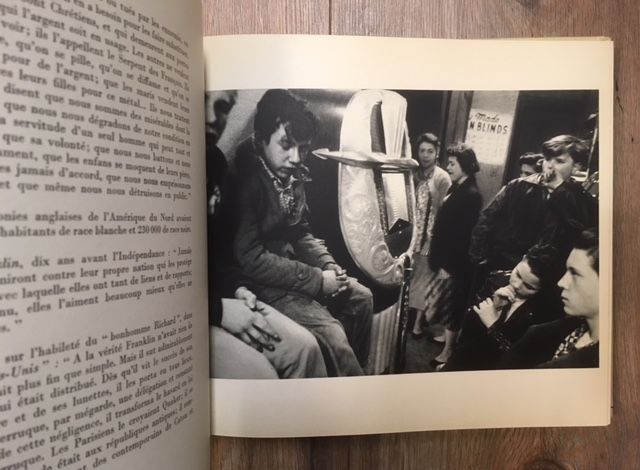
Robert Frank, Les Americains (French edition, 1958), spread
So he engaged Alain Bosquet, an Odessa-born surrealist poet and old-school cosmopolitan who had lived in the States for several years during World War II, to generate an accompanying text. This emerged as a collage of bits and pieces of writings and speeches and other materials about the United States taken from a grab-bag of sources, half American and half French, with a few Brits thrown in for good measure: Alexis de Tocqueville, Ulysses S. Grant, Simone de Beauvoir, Harry Truman, André Malraux, Oscar Wilde, Jean Giraudoux, Mary McCarthy, etc. Though obviously dated, it proves an engaging compilation — and therein lies the problem.
Fortunately (or not, in this case), as I’m bilingual Francophone I can read and understand the text. So, while I hardly qualify as the typical French reader, I have more than an inferential sense of what said reader would have encountered when interacting with this version of Frank’s opus.
•
The presence of all that text has several predictable effects on the reader. First and foremost, given our habits of reading printed books with pictures in them, it instantly proposes Frank’s images as illustrations of — or at least bearing some relationship to — whatever commentary appears on the facing verso,. This both literalizes the images and decontextualizes them, separating each from the through-composed, purely visual structure that Frank had intended.
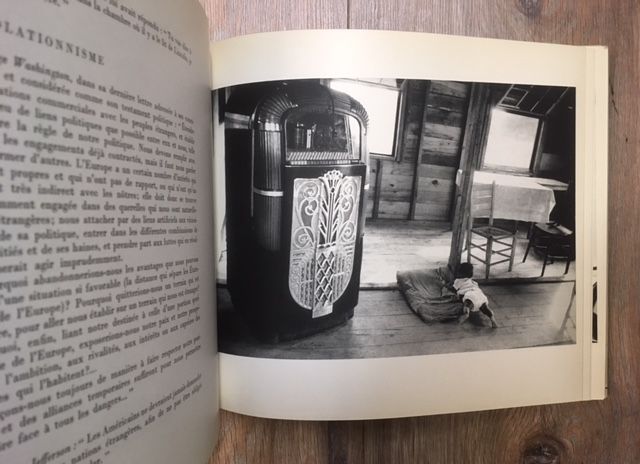
Robert Frank, Les Americains (French edition, 1958), spread
Second, no correlations pertain between these texts and Frank’s images. The content and tone and pacing of Bosquet’s compilation have no connection to — indeed, operate contrary to — the coherent, minor-key music of Frank’s sequence, its nuanced rhythms and moods. For example, across from one of the later images in Frank’s sequence, a twilight view looking down from a hotel window at a Los Angeles side street with a lone male figure walking beneath a long neon arrow, the opposite text has Gen. Omar Bradley describing Gen. George Patton slapping the face of a hospitalized, shell-shocked G.I. during World War II.
Third, by drawing the reader into an effort to find nonexistent connections between images and texts it distracts from Frank’s individual pictures and their subtle relationships with each other, because this is a dense running text, each page of it not mere snippets but 350-400 words’ worth of prose. Even if one opts to ignore the text and simply attend to the images on the right-hand side of each spread, as I did for one go-through, the visual presence of all that text impinges on one’s consciousness, as audible voices to which one must deliberately turn a deaf ear.
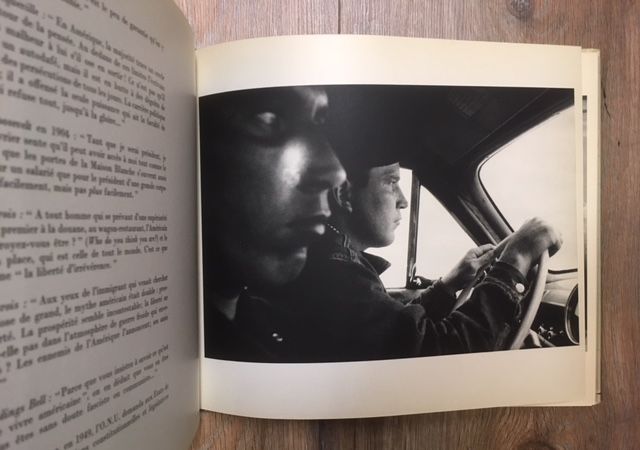
Robert Frank, Les Americains (French edition, 1958), spread
Fourth, it juxtaposes Frank’s determinedly (and, at the time, radically) first-person-singular present-tense visual voice with a polyvocal, achronological 200-year jumble of perspectives, a veritable cacophony. And fifth, it makes Bosquet as compiler of the textual collage in effect co-equal with Frank, a collaborator with him on the book as a whole — an unfortunate but inevitable perception given the equal weight the book grants to words and images.
Imagine, if you will, any epic poem you have read combined in layout with other authors’ commentaries on the country and culture in which that poem was set, and you have something like the net effect of these editorial and design decisions.
•
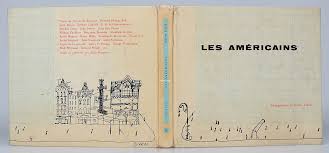
Robert Frank, Les Americains (French edition, 1958), cover
Delpire did not even have the assurance to use one of Frank’s images on the cover, employing instead a detail from a cartoon by Saul Steinberg. Were it not for the words “Photographies de Robert Frank” in small red type on the front cover, you wouldn’t know from looking at it that you held a book of photographs in your hands.
However, to his credit, Delpire did at least maintain the integrity of Frank’s sequence, which appears there exactly as it would in the subsequent U.S. edition, one image to a two-page spread. I verify this by placing next to it the library’s copy of the 2009 exhibition catalog Looking In: Robert Frank’s The Americans. Edited by Sarah Greenough, this study includes the entire 83-image sequence, presented as a chapter in itself, so I go through both, one page at a time. All there, all in order, just as Frank intended.

Sarah Greenough, ed., Looking In: Robert Frank’s The Americans (2009), cover
In fairness to Delpire, who took at the very least a financial risk in publishing this first monograph by a relatively unknown and uncelebrated photographer, it would seem that he offset that gamble somewhat by shoehorning Frank’s book into a series already established under his Robert Delpire Éditeur imprint: “Encyclopédie Essentielle,” of which Les Américains formed the third volume. The previous titles consisted of thematically edited compilations of otherwise unrelated images, e.g., Arts Sauvages (Primitive Art, 1957) and Paris fin de siècle (Turn-of-the-century Paris, published in 1958), with the same basic design and layout and the same approach to editorial content. Presumably he hoped that purchasers of the first two volumes would want to own another in that format — what we would come to call coffee-table books — even if the visual content differed considerably from its predecessors.
•
Unlike Delpire, Barney Rosset of Grove Press at least understood what Frank had achieved, and published it as its maker conceived it. So, for the first U.S. edition issued in 1959 under his Grove Press imprint, he provided a simple cover design featuring one of Frank’s key images, and engaged Jack Kerouac (whose fiction and poetry he had already published) to write an introduction, presumably with the hope — groundless, as it turned out — that the newly famous Beat novelist’s endorsement would help to sell the book.
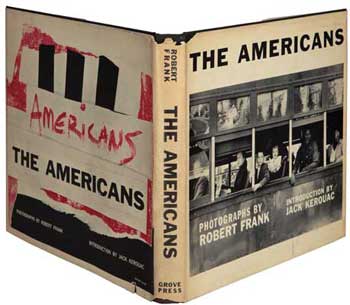
Robert Frank, “The Americans,” first U.S. edition, 1959.
Kerouac had already collaborated with Frank on the classic underground film Pull My Daisy, released that same year. More importantly, he understood what Frank has achieved, speaking both to the specifics of individual images and the overall thrust of the work:
Anybody doesn’t like these pitchers don’t like poetry, see? Anybody don’t like potry go home see television shots of big hatted cowboys being tolerated by kind horses. Robert Frank, Swiss, unobtrusive, nice, with that little camera that he raises and snaps with one hand he sucked a sad poem right out of America onto film, taking rank among the poets of the world. To Robert Frank I now give this message: You got eyes.
Otherwise Rosset and his designer stayed out of Frank’s way, simply following the layout of Frank’s maquette, letting the pictures, individually and collectively, speak for themselves — one image full-page on the recto of every two-page spread, with only its caption (merely the location of its making) unobtrusively positioned in the lower left-hand corner of the facing verso.
That this edition failed commercially doesn’t really matter; through it Frank’s visionary project made its way into the world, and into cultural consciousness, on its own terms.
•
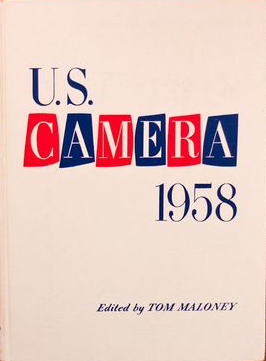
U.S. Camera 1958. cover
Prior to the appearance of this French edition, the editor of the monthly newsstand magazine U. S. Camera and its hardcover annual, Tom Maloney, devoted a large section of the magazine’s 1958 annual to Frank’s work from his Guggenheim years. Maloney had it designed as a self-contained booklet or insert, as if he anticipated photographers extracting it so they could study it on its own (although it comes bound it to the sewn binding, so you’d have to razor it out). Running from pages 90-115, it comprises 35 images in all. It does not in any way follow the sequence Frank devised, and in fact contains over a dozen images that do not appear in the eventual books.
Perhaps Frank had not yet finished his redaction for the French edition; the U.S. Camera Annual came out late in the year before its title year (in this case, December 1957), each issue distilling material submitted or solicited during that year. On the table of contents page, Maloney presents the Frank portfolio not as an excerpt from a recent or forthcoming book but a selection of work done on a Guggenheim fellowship; Frank, in his comments, indicates that the French edition will appear soon.
The section begins with a stirring defense of Frank by Walker Evans, and ends with Frank’s own “A Statement,” both of them now much-quoted texts. The portfolio itself is oddly designed; its pages are the same length as the volume’s other pages but only two-thirds the same width. (Perhaps someone has discovered the how and why of this decision; if so, I haven’t come across that.)
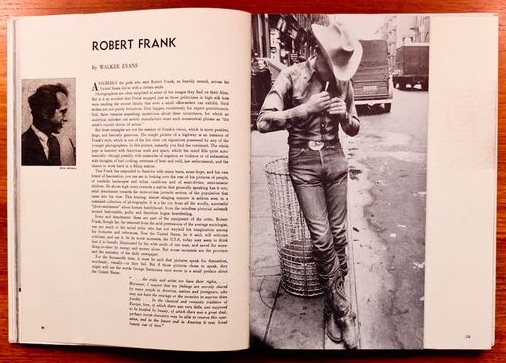
U.S. Camera 1958, Robert Frank portfolio, opening spread
In any case, given the challenging quality of Frank’s work — which would draw derision in the pages of Popular Photography, U.S. Camera‘s newsstand competitor, when the American edition appeared a year later — it took editorial courage for Maloney to devote this much attention (not to mention the attendant expense) to a project by a newcomer. Interestingly, as if to tie Frank into the U.S. photo scene, Maloney followed this portfolio with a considerably smaller one by New York School street photographer Harold Feinstein.
A remarkable prelude to the book that would follow shortly, whose French and U.S. editions would permanently alter the course of the medium.
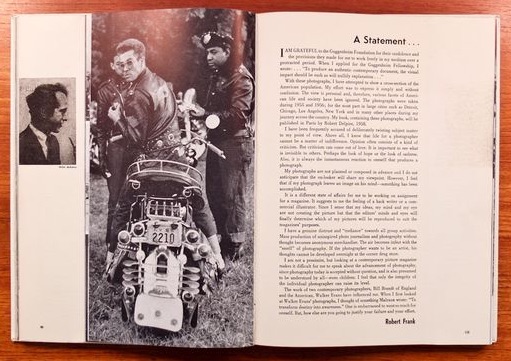
U.S. Camera 1958, Robert Frank portfolio, closing spread
•
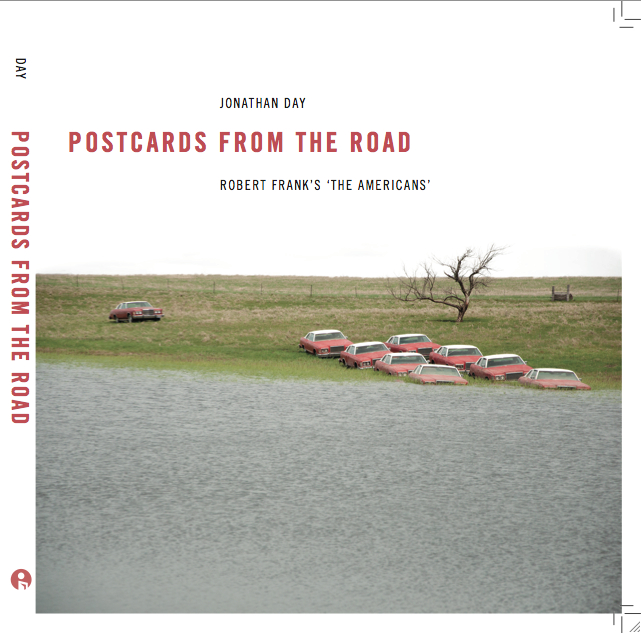
Jonathan Day, Postcards from the Road (2014), cover
In pulling up the library’s listings of Frank-related items I discovered Jonathan Day’s Postcards from the Road: Robert Frank’s ‘The Americans’ (Bristol UK / Chicago USA: Intellect, 2014), a remarkable meditation on Frank’s project. Day, a British writer, photographer, scholar, and teacher, weaves together three threads here: Precise, thoughful commentary on Frank’s images, one by one, as they appear in The Americans; his own autobiographical ruminations as he travels through the U.S. over a period of years; and his own color photographs, made in the spirit of Frank’s own. A most unusual meditation, which I ingested in installments and intend to revisit.
•
This post sponsored by a donation from Carlyle T.
•
Special offer: If you want me to either continue pursuing a particular subject or give you a break and (for one post) write on a topic — my choice — other than the current main story, make a donation of $50 via the PayPal widget below, indicating your preference in a note accompanying your donation. I’ll credit you as that new post’s sponsor, and link to a website of your choosing.
 Include a note with your snail-mail address (or email it to me separately) and I’ll include three (3!) copies of The Silent Strength of Liu Xia, the catalog of the 2012-13 touring exhibition of photos by the dissident Chinese photographer, artist, and poet, who, after eight years of extralegal house arrest in Beijing, finally got released and expatriated to Germany in 2018. The only publication of her photographic work, it includes all 26 images in the exhibition, plus another 14 from the same series, along with essays by Guy Sorman, Andrew Nathan, and Cui Weiping, professor at the Beijing Film Academy. Keep one for yourself, share the others with friends.
Include a note with your snail-mail address (or email it to me separately) and I’ll include three (3!) copies of The Silent Strength of Liu Xia, the catalog of the 2012-13 touring exhibition of photos by the dissident Chinese photographer, artist, and poet, who, after eight years of extralegal house arrest in Beijing, finally got released and expatriated to Germany in 2018. The only publication of her photographic work, it includes all 26 images in the exhibition, plus another 14 from the same series, along with essays by Guy Sorman, Andrew Nathan, and Cui Weiping, professor at the Beijing Film Academy. Keep one for yourself, share the others with friends.






Leave a Comment